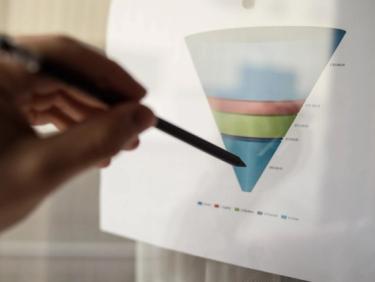Insight10 min read
PPC marketing funnel: Four stages to customer acquisition
Thu Oct 29 2020 | Marketing Team

- Insight
- Performance
- PPC
Tags
As a business owner or marketer, it’s your job to guide your customers through their shopping journey. The digital marketing funnel is a long-standing concept based on attracting relevant users to your site and guiding them to conversion. In this blog, we’re talking specifically about the four-stage PPC marketing funnel, from awareness all the way through to action. This funnel approach is great for encouraging you to segment your audience based on their level of intent and therefore needs at that time, making your paid media efforts even more targeted and relevant to the user. By effectively aligning your PPC marketing to the different stages of the sales funnel, you can generate the best performance possible from your campaigns.
Could your PPC campaigns create a better ROI for your business?
The user journey
Journeys aren’t always straight forward. Sometimes they can be long and tiresome with lots of ups, downs and bumps in the road before you finally reach your destination. Depending on the route a user chooses to take, their journey may be longer or shorter than others. The same applies to the customer journey. Your audience won’t take the same route to conversion, and they won’t do it at the same speed either. This is why targeting specifically based on their buying signals is a huge part of PPC success. This sentiment is reflected in the PPC marketing funnel. You need to adjust the way you approach your users as their needs change at each stage of the funnel. If you can create ads that align with the user’s specific needs at that specific moment, you’re much more likely to guide them towards that all-important conversion. After all, brands aren’t made overnight. It takes time, investment and know-how to attract your target audience and help them see just how great your offering is.
What are the stages of the PPC marketing funnel?
When it comes to the PPC marketing funnel, there are four stages to customer acquisition:
- Awareness:Top of funnel - the first stage in the user journey. Your audience might not know you yet, but their behaviour suggests an interest in your brand’s offering.
- Discovery: Middle of funnel - users already know what they want at this stage but they’re still researching who to convert with.
- Consideration: Middle of funnel - you’re in the mix and it’s only a matter of time before a user decides who they will convert with.
- Action: Bottom of funnel - the final stage where a user takes action and a conversion is made.
How can you reach your audience at each stage?
It’s a necessity to understand your prospects’ journey within each stage of the funnel and what they’re looking for. Fortunately, paid media offers many different channels to support this effectively. Let’s consider each stage of the PPC marketing funnel.
Top of funnel
Top of funnel (TOFU), or the awareness stage, involves creating PPC strategies to reach relevant users who are unaware of your brand. This stage requires educating the audience on who you are by raising brand awareness and bringing them to your website. This could be done through:
- Display ads: Using display ads, you can broadly target a relevant audience through a range of platforms including websites, blogs, mobile apps and social media. Ads which promote value and education such as blogs, guides and white papers are effective during this stage.
- Paid search: Most searchers will use non-branded keywords at this stage. To leverage their intent, paid search advertising featuring generic keyword targeted campaigns can be used to drive high-quality website traffic from the search engine. For example, a user researching shelving options may search for ‘shelving ideas’ or ‘shelving reviews’ at this stage of their journey.
- Digital out of home: Merging the online and offline worlds, digital out of home (DOOH) can reach your audience through targeted ads to increase your brand exposure – ideal for those in the awareness stage.
- Shopping: Relevant for eCommerce businesses only, Google Shopping can be used at each stage of the funnel. When users begin searching for products during the awareness stage, the Shopping tab is an effective place to find out more information about what is available and from who, edging them closer to MOFU.
- Social media ads: Target your audience based on a specific topic or interest across social channels. These platforms are ideal for engaging with prospects during the awareness stage and building a connection.
- Video ads: A range of ad formats and targeting options make YouTube an effective platform to raise brand awareness with in-market audiences.
Middle of funnel
Middle of funnel (MOFU) users are closer to making a decision. Having travelled through the awareness stage, they are interested in learning more about the product or service and who to purchase it from. Suitable campaign types could include:
- Paid search: Using paid search advertising, you can continue serving relevant ads to people who are now actively searching for a product or service they are interested in to encourage a response. Understanding the intent behind the click triggers lasting success so it’s important to use certain keywords based on what the user is searching for. During this stage, the intent has increased and become more specific, so keywords need to be adapted to reflect this. For example, phrases could now include ‘floating shelves for kitchen’ or ‘wooden kitchen shelves’.
- Display ads: Delving deeper into display targeting, your ads can be shown to specific audiences based on what they’ve shown interest in or how they may have already interacted with your site. This insight allows you to create relevant ad messaging accompanied with visuals to produce an engaging result for the user.
- Shopping: Shopping can also be used during the MOFU as the user becomes more specific with their product intent. For example, a simple search for ‘jeans’ during the awareness stage could then elaborate to ‘grey boyfriend style jeans’ in the MOFU which will help to display more relevant results.
- Remarketing: During this stage, a user may have already interacted with your brand but not yet converted. This makes it an ideal time to introduce remarketing to encourage them back onsite. Ensure your messaging is relevant and engaging for a user to return to your site over a competitor.
Bottom of funnel
The final stage of the customer journey, also known as BOFU, is where the user has the strongest conversion intent. Even at this stage, there are still a number of paid media channels that can be used to better the odds of them converting with you.
- Shopping campaigns: Google Shopping can be used to draw high intent users into making a purchase. Through effective ad and feed management, your Shopping campaigns can be optimised and geared towards those who are most likely to convert based on specific and branded keywords.
- Paid search: Paid search advertising doesn’t stop there. With the use of the correct keywords, high intent search ads can be made specifically for this stage of the journey to trigger a conversion. Now is the time to use your most specific keywords based on the user’s signals. These could include ‘wooden floating shelves under £100’ or ‘buy wooden kitchen shelves’.
- Branded search ads: At this stage, there is a chance the user will be so aware of your brand’s offering that they may even use branded search terms to shop directly with you. Don’t miss out on these high-value prospects, instead, use branded search ads to capture their intent such as ‘wooden floating kitchen shelves IKEA’.
- Remarketing ads: Remarketing is also ideal for the BOFU. Deploying relevant ads with impactful messaging such as an applicable discount, you can tempt shoppers back to your website. Using remarketing strategies, leads can be turned into sales by directing budget at those who are more likely to convert.
Key takeaways
To make your paid media efforts work harder for your business, it’s important to have the customer journey in mind. The aim is to capture the attention of your audience and guide them to convert with you. Using the PPC marketing funnel concept, you’re in a better position to engage with your audience in the way they want to be engaged with. As a Google Premier Partner and expert paid media agency, our approach to PPC marketing is designed to reduce waste, save budget and drive conversions. We can identify potential new customers before they engage with your brand or attract users back who didn’t convert the first time. If you want to find out more about unlocking the full potential of your PPC campaigns, don’t hesitate to get in touch.


